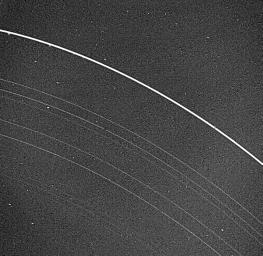
|
Uranus Rings
- Click the image above for a larger view
- Full-Res JPEG (754 x 735) (190.2 kB)
- Full-Res TIFF (754 x 735) (578.5 kB)
Caption:
Voyager 2 returned this picture of the Uranus rings on Jan. 22, 1986, from a distance of 2.52 million kilometers (1.56 million miles). All nine known rings are visible in this image, a 15-second exposure through the clear filter on Voyager's narrow-angle camera. The rings are quite dark and very narrow. The most prominent and outermost of the nine, called epsilon, is seen at top. The next three in toward Uranus -- called delta, gamma and eta -- are much fainter and more narrow than the epsilon ring. Then come the beta and alpha rings and finally the innermost grouping, known simply as the 4, 5 and 6 rings. The last three are very faint and are at the limit of detection for the Voyager camera. Uranus' rings range in width from about 100 km (60 mi) at the widest part of the epsilon ring to only a few kilometers for most of the others. This image was processed to enhance these narrow features; the bright dots are imperfections on the camera detector. The resolution scale is approximately 50 km (30 mi).
Background Info:
The Voyager project is managed for NASA by the Jet Propulsion Laboratory.
Cataloging Keywords:
| Name | Value | Additional Values |
|---|---|---|
| Target | Uranus Rings | Alpha Ring, Beta Ring, Epsilon Ring, Five Ring, Six Ring, Uranus |
| System | Uranus | |
| Target Type | Ring | Planet |
| Mission | Voyager | |
| Instrument Host | Cassini Orbiter | Voyager 2 |
| Host Type | Orbiter | Flyby Spacecraft |
| Instrument | Imaging Science Subsystem (ISS) | |
| Detector | Narrow Angle Camera | |
| Extra Keywords | Disk, Grayscale, Visual | |
| Acquisition Date | ||
| Release Date | 1999-06-21 | |
| Date in Caption | 1986-01-22 | |
| Image Credit | NASA/JPL | |
| Source | photojournal.jpl.nasa.gov/catalog/PIA01977 | |
| Identifier | PIA01977 | |
